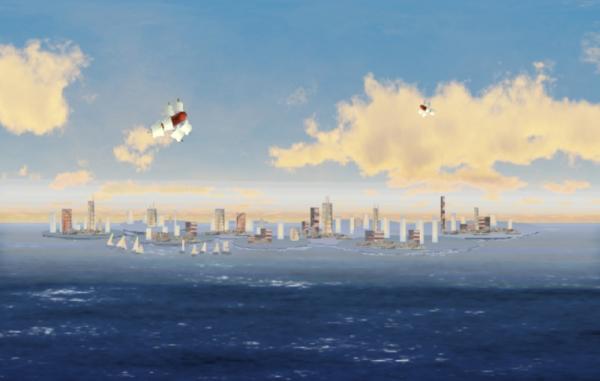BY LETTER
NeoAtlantia
 Image from Steve Bowers | |
| Floating city located in the Bohr Strait between Gzeut and Quark on Corona. | |
Originally founded as New Atlantis in 1845 a.t., Neo Atlantia was an unremarkable habitat until 2106 a.t., where the Godslist constructed a large undersea computronium storage unit below Neo Atlantia and moved their main archive to Corona as the first step in forming a new and improved Grand List. The influx of researchers and administrators changed the platform above from a single sleepy habitat into an energetic hub of reporting, research and trade in transapient information. This remained the case throughout the great Godslist scandal, the legal and reputational battles, and the acquisition of the Godslist by the Universalist Church in 2675. The Universalist Church decided not to move the main archive, and added sorely needed computronium to the expanding list, as well as a few new facilities requested by the Godslist's researchers. Since then, Neo Atlantia has slowly expanded along with the Terragen civilisation, and the growing number of transapients.
Currently the city is approximately ten kilometers in diameter, consisting of more than 5000 separate floating platforms, held together by a multitude of bridges and walkways. The very core of the city is the eleven platforms holding the official Institute of the Godslist Database, a series of buildings that have grown into a single mass over time, in a harmonious display of various architectural styles. In the outer core one can find a multitude of buildings, some dedicated to the Godslist such as peripheral research institutes or toposophic analysts, some dedicated to the Godslist's employees such as the prestigious investigator clubs, and a multitude of restaurants, hotels and other service buildings catering to employees and tourists alike. The western rim of the city is dominated by the low, spacious houses of the locals, many with private gardens and direct access to the canals between the platforms. The eastern rim of the city seems more or less like a single organic mass divided only by the canals, the platforms here being the largest of the city. Tourists, amateur researchers, or pilgrim godchasers can either rent apartments on the platforms closest to the core, or move into the more spartan rooms that the Universalist Church provides free of charge farther towards the rim.
Travel from the eastern rim to the core is usually either by foot in the covered corridors of the biosculpted structures, or by the sub, the local subsurface PRT network. The locals of the western rim on the other hand are more fond of personal water vehicles, though some have built their home so that they have access to the sub. In the core, travel is done in equal parts by foot, boat and the sub, which travels up into most major buildings. If it is the small cafés and street performers that interest the visitor, the street can be reached directly from sub stations located at the various plazas. The sub is a local network of transparent maglev tunnels, connecting the entire city beneath the surface of the sea. Individual sub cars are constantly cycling around in the system, and can be called with the press of a button, in most places resulting in a wait of less than five seconds for a car. A standard sub car is constructed with seating for four persons, though there are also larger cars in the system. The transparent sub cars provide a beautiful view of the marine life gathering around the artificial reef around the Godslist's computronium storage facility. Local inhabitants using the sub usually have personalized cars.
Travel to and from Neo Atlantia is usually performed by the maglev lines to either Albertgrad or Delphi for speed and convenience. However, the city has the facilities to support water or air transport as well, and locals usually use either personal sailships or Atlantean airships for casual travel.
Related Articles
Appears in Topics
Development Notes
Text by Thorbjørn Steen
Initially published on 15 May 2007.
Initially published on 15 May 2007.






